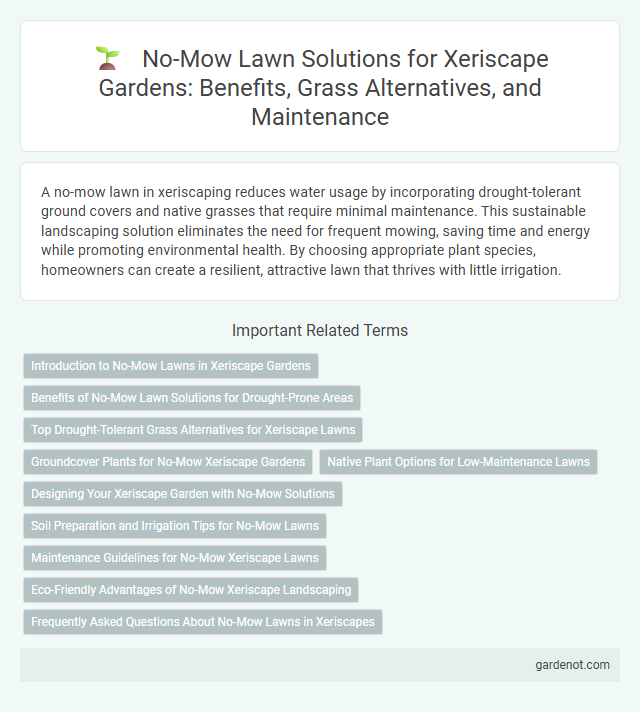A no-mow lawn in xeriscaping reduces water usage by incorporating drought-tolerant ground covers and native grasses that require minimal maintenance. This sustainable landscaping solution eliminates the need for frequent mowing, saving time and energy while promoting environmental health. By choosing appropriate plant species, homeowners can create a resilient, attractive lawn that thrives with little irrigation.
Introduction to No-Mow Lawns in Xeriscape Gardens
No-mow lawns are an innovative xeriscape solution that reduces water usage by utilizing low-growing grasses and drought-tolerant plants requiring minimal mowing. These lawns promote sustainable landscaping by conserving water, reducing maintenance costs, and supporting local ecosystems. Incorporating native grasses like buffalo grass and fine fescue enhances soil health and biodiversity while maintaining an attractive, natural appearance.
Benefits of No-Mow Lawn Solutions for Drought-Prone Areas
No-mow lawn solutions significantly reduce water consumption in drought-prone areas by eliminating the need for frequent irrigation associated with traditional grass lawns. These low-maintenance landscapes promote soil health, decrease carbon emissions from lawn equipment, and support local biodiversity by incorporating native, drought-resistant plants. Adopting no-mow lawns also lowers long-term landscaping costs while creating resilient green spaces that thrive under limited water conditions.
Top Drought-Tolerant Grass Alternatives for Xeriscape Lawns
Buffalo grass, Bermuda grass, and Zoysia grass are top drought-tolerant alternatives ideal for xeriscape lawns. These grasses require minimal watering, thrive in heat, and reduce maintenance costs by eliminating frequent mowing. Choosing no-mow varieties like native buffalo grass enhances water conservation while maintaining a lush, green appearance year-round.
Groundcover Plants for No-Mow Xeriscape Gardens
Groundcover plants such as Creeping Thyme, Sedum, and Blue Star Creeper provide low-maintenance, drought-tolerant alternatives for no-mow xeriscape gardens. These species thrive in arid conditions, reducing water usage while suppressing weeds and preventing soil erosion. Choosing native and drought-resistant groundcovers optimizes landscape sustainability and enhances xeriscape garden aesthetics.
Native Plant Options for Low-Maintenance Lawns
No-mow lawns incorporating native plants such as buffalo grass, blue grama, and fine fescues thrive in xeriscape landscapes by requiring minimal irrigation and mowing. These drought-resistant species enhance soil health, support local wildlife, and reduce maintenance costs compared to traditional turfgrass. Selecting region-specific native plants ensures sustainability and promotes biodiversity within low-maintenance lawn designs.
Designing Your Xeriscape Garden with No-Mow Solutions
Designing your xeriscape garden with no-mow solutions reduces water consumption by incorporating drought-tolerant ground covers such as clover, creeping thyme, and native grasses. These plants require minimal maintenance while enhancing soil health, preventing erosion, and supporting pollinators. Integrating no-mow areas also decreases the need for fertilizers and gas-powered lawn equipment, promoting eco-friendly landscaping.
Soil Preparation and Irrigation Tips for No-Mow Lawns
Soil preparation for no-mow lawns involves loosening the soil to improve aeration and incorporating organic matter to enhance moisture retention and nutrient availability. Efficient irrigation systems such as drip irrigation or soaker hoses deliver water directly to the root zone, minimizing evaporation and runoff. Adjusting watering schedules according to soil moisture levels ensures healthy grass growth while conserving water.
Maintenance Guidelines for No-Mow Xeriscape Lawns
No-mow xeriscape lawns require minimal maintenance, focusing primarily on occasional trimming of native grasses and removal of invasive weeds to preserve ecosystem balance. Watering needs are reduced by selecting drought-tolerant plants and using efficient irrigation systems like drip emitters to prevent overwatering. Regular monitoring for pests and soil health ensures long-term sustainability while maintaining the natural, low-maintenance aesthetic characteristic of xeriscape landscapes.
Eco-Friendly Advantages of No-Mow Xeriscape Landscaping
No-mow xeriscape landscaping significantly reduces water consumption by incorporating drought-tolerant plants that thrive with minimal irrigation. This eco-friendly approach minimizes emissions linked to traditional lawn mowing and eliminates the need for chemical fertilizers and pesticides, promoting healthier soil and biodiversity. By lowering maintenance demands and conserving natural resources, no-mow xeriscapes contribute to sustainable urban environments.
Frequently Asked Questions About No-Mow Lawns in Xeriscapes
No-mow lawns in xeriscapes require minimal maintenance, reducing water usage by up to 50% compared to traditional grass. Common questions include the best drought-tolerant grass species such as fescues, blue grama, and buffalo grass, which thrive with infrequent mowing. Homeowners also inquire about weed control and irrigation practices, with drip irrigation and seasonal spot treatments recommended to maintain healthy, low-maintenance lawns.
No-mow lawn Infographic

 gardenot.com
gardenot.com